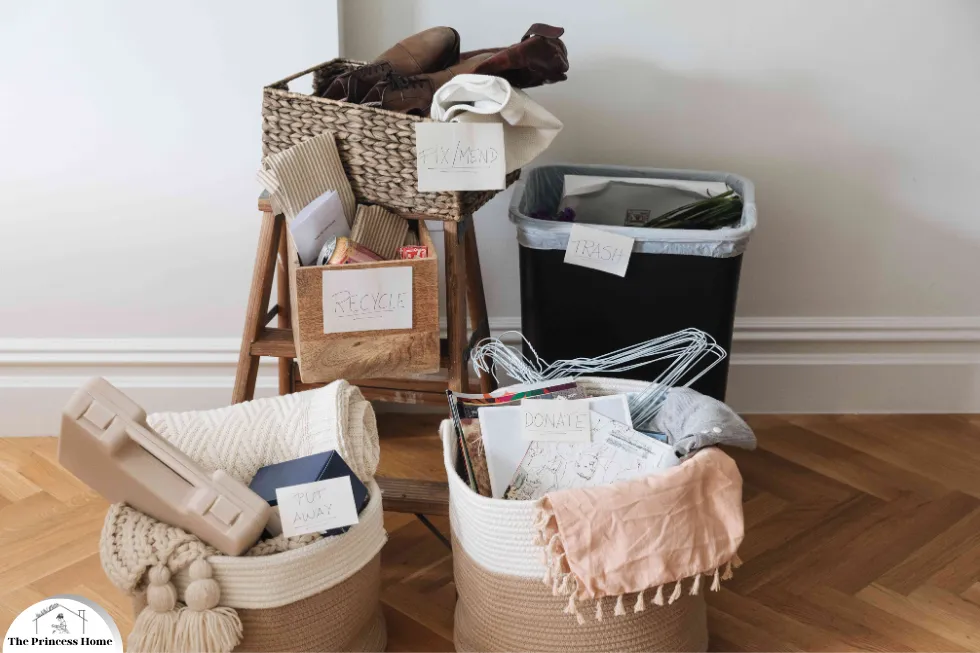

How to Stop Impulse Buying : In a world saturated with advertisements, tempting sales, and constantly evolving trends, impulse buying has become a common behavior for many people. It can be an expensive habit that not only drains your wallet but also fills your home with unnecessary clutter. This article explores the psychology behind impulse buying and offers practical strategies to curb the urge and declutter your life.
Breaking free from the cycle of impulse buying and clutter accumulation requires dedication and self-awareness. By understanding the psychological triggers of impulsive spending and implementing the strategies mentioned above, you can regain control over your finances, declutter your life, and make mindful, intentional purchasing decisions that align with your long-term goals and values. Remember, less clutter and financial freedom can lead to a happier, more fulfilled life.

1.Understanding Impulse Buying
Impulse buying is the act of making unplanned purchases, often driven by emotions rather than rational decision-making. It’s fueled by factors such as instant gratification, peer pressure, and clever marketing tactics. Recognizing the triggers behind impulse buying is the first step toward overcoming it.
Identify Your Triggers:
Take a moment to reflect on what prompts your impulse purchases. Is it stress, boredom, loneliness, or simply the desire to keep up with others?
By pinpointing these triggers, you can develop strategies to address them more effectively.
- 1.Emotional Triggers: Stress, boredom, and even happiness can trigger impulse buying. Retail therapy is a real phenomenon, where people turn to shopping to alleviate emotional stress.
- 2.Peer Pressure: The desire to fit in or keep up with friends and family members who shop excessively can lead to impulsive purchases.
- 3.Scarcity Mentality: The fear of missing out on a great deal or a limited-time offer often drives people to buy things they don’t actually need.
Marketing Tactics: Retailers employ various tactics to encourage impulse buying, such as strategically placing items at eye level or near the checkout counter, creating a sense of urgency, and offering limited-time discounts.

2.The Consequences of Impulse Buying
While impulse buying can provide temporary satisfaction, it often leads to several negative consequences:
- Financial Strain: Frequent impulse buying can strain your budget and lead to overspending.
- Clutter: Unplanned purchases contribute to clutter, making your home feel disorganized and stressful.
- Regret: After the initial excitement, many people regret impulse purchases, leading to feelings of guilt and remorse.

3.How to Stop Impulse Buying
Breaking the cycle of impulse buying requires self-awareness and commitment. Here are some effective strategies to help you curb impulsive spending and declutter your life:
1.Create a Budget
Setting a budget is essential for responsible spending. Allocate specific amounts for essentials, savings, and discretionary purchases. By adhering to a budget, you’ll have a clearer understanding of your financial limits and be less likely to succumb to impulsive splurges. Creating a budget is a fundamental step towards achieving financial stability and peace of mind. Whether you’re aiming to pay off debt, save for the future, or simply manage your day-to-day expenses more effectively, a well-thought-out budget can provide the roadmap you need.
Here’s how to create a budget that works for you:
- Calculate Your Income: Determine your total monthly income after taxes.
- Track Expenses: Review your spending over the past few months to understand where your money is going.
- Set Goals: Identify your financial priorities, such as paying off debt or saving for a vacation.
- Allocate Funds: Divide your income into categories like essentials, savings, and discretionary spending.
- Be Realistic: Balance responsible spending with occasional indulgences.
- Monitor Spending: Keep track of your expenses and adjust your budget as needed.
- Plan for Irregular Expenses: Budget for unexpected costs like car repairs or gifts.
- Build an Emergency Fund: Save for emergencies with three to six months’ worth of living expenses.
- Review Regularly: Assess your progress and make changes to your budget as necessary.
- Seek Help if Needed: Consider consulting a financial advisor for personalized advice.

2.Make a Shopping List
Before embarking on a shopping trip, prepare a list of items you genuinely need. Stick to the list and resist the temptation to deviate from it. This not only helps curb impulse buying but also ensures that you focus on acquiring what truly matters. Creating a shopping list is a simple yet powerful way to stay focused and avoid unnecessary purchases.
Here’s how to do it effectively:
- Assess Needs: Identify what you genuinely need to buy.
- Prioritize Essentials: List essential items first, like groceries or household supplies.
- Plan Meals (for groceries): Outline meals for the week to avoid overbuying.
- Check Supplies: Avoid duplicates by checking what you already have.
- Set Budget: Determine how much you can spend and stick to it.
- Specific Items: Be precise in listing what you need.
- Stick to List: Resist deviating from your list to avoid impulse purchases.
- Avoid Shopping Hungry: Eat beforehand to prevent unnecessary purchases.
- Use Digital Tools: Consider using apps for easy list management.
- Review and Revise: Evaluate purchases and adjust future lists accordingly.

3.Delay Gratification
Implement a cooling-off period before making non-essential purchases. For instance, wait 24 hours before buying something on impulse. This delay allows you to reassess whether the purchase is truly necessary or merely a fleeting desire. Delaying gratification is a powerful strategy to overcome impulse buying and make more intentional purchasing decisions.
Here’s how to implement it effectively:
- Set a Waiting Period: Wait 24 hours before making non-essential purchases.
- Create a Wishlist: Add desired items to a list and revisit them later.
- Reflect: Use the waiting period to consider if the purchase is necessary.
- Explore Alternatives: Look for cheaper options or assess if you truly need the item.
- Assess Value: Consider the long-term value and utility of the purchase.
- Practice Mindfulness: Be aware of your emotions and motivations.
- Celebrate Self-Control: Recognize and celebrate your ability to delay gratification.

4.Unsubscribe from Marketing Emails
Limit your exposure to environments or websites that encourage impulse buying. Unsubscribe from promotional emails, unfollow brands on social media, and avoid browsing online stores aimlessly. By reducing temptation, you’ll find it easier to stick to your mindful consumption goals.
To curb impulse buying, minimize exposure to tempting offers by:
- Unsubscribing from Emails: Remove yourself from promotional email lists to reduce temptation.
- Unfollowing Brands: Avoid being influenced by brands on social media by unfollowing them.
- Avoiding Aimless Browsing: Refrain from casually browsing online stores to prevent impulse purchases.
- Sticking to Goals: By reducing temptation, you’ll find it easier to stay committed to your mindful consumption objectives.
Unsubscribe
Social media influencers often promote products, making it easy to fall into the trap of buying items you don’t need. Unfollow or mute influencers who trigger your impulsive spending habits.
To avoid impulsive spending influenced by social media:
- Identify Triggers: Recognize influencers or content that tempt you to make unnecessary purchases.
- Take Action: Unfollow or mute influencers who consistently promote products that trigger impulsive spending.
- Curate Your Feed: Follow accounts that align with your values and interests, focusing on content that inspires rather than promotes consumption.
- Limit Exposure: Reduce the time spent scrolling through social media to minimize exposure to tempting content.
- Stay Mindful: Be aware of the influence social media has on your spending habits and make intentional choices about who and what you follow.
By taking control of your social media feed, you can reduce the temptation to make impulsive purchases and cultivate more mindful consumption habits.

5.Set Savings Goals
Establish specific savings goals, such as building an emergency fund or saving for a vacation. Knowing that your money is working towards something meaningful can deter you from spending impulsively. Setting savings goals is essential for financial stability and curbing impulse spending.
Here’s how to do it effectively:
- Identify Goals: Determine what you’re saving for, like an emergency fund or a vacation.
- Set Specific Targets: Define clear and achievable savings goals, such as saving $5,000 for emergencies.
- Assign Deadlines: Establish timelines for reaching each goal, adding urgency.
- Break it Down: Divide larger goals into smaller, manageable milestones.
- Automate Savings: Set up automatic transfers to ensure consistent progress.
- Track Progress: Monitor your savings regularly using tools like apps or spreadsheets.
- Stay Motivated: Visualize the benefits of reaching your goals and celebrate milestones.
- Review and Adjust: Periodically reassess your goals and adjust as needed based on changes.

6.Avoid Shopping
Avoid shopping when you’re feeling stressed, sad, or bored. Find alternative ways to manage your emotions, such as exercise, meditation, or spending time with loved ones.
To avoid impulse shopping:
- Recognize Triggers: Identify emotions like stress, sadness, or boredom that lead to shopping urges.
- Find Distractions: Engage in mood-lifting activities such as exercise, meditation, or spending time with loved ones.
- Practice Mindfulness: Tune into your emotions and thought patterns when the urge to shop arises.
- Delay Gratification: Wait before making non-essential purchases to assess their necessity.
- Remove Temptations: Unsubscribe from marketing emails, unfollow brands on social media, and limit exposure to tempting offers.
- Seek Support: Share your goals with friends or family for encouragement and accountability.

7.Practice Mindful Shopping
Be mindful of your thoughts and emotions when tempted to make impulse purchases. Pause and ask yourself if buying the item aligns with your long-term goals and values. Cultivating mindfulness enables you to make more intentional choices that contribute to your overall well-being.
To practice mindful shopping:
- Be Aware: Notice your thoughts and emotions when tempted to buy impulsively.
- Pause: Take a moment to stop and assess whether the purchase aligns with your long-term goals and values.
- Reflect: Consider the implications of the purchase on your finances, lifestyle, and well-being.
- Ask Questions: Is this item a genuine need or just a momentary desire? Will it bring lasting satisfaction or regret?
- Prioritize: Focus on what truly matters to you and whether the purchase supports those priorities.
- Practice Gratitude: Appreciate what you already have and consider whether the new purchase adds genuine value to your life.
By practicing mindfulness in your shopping habits, you can make more intentional choices that lead to greater satisfaction and well-being in the long run.

8.Organize and Declutter
Clutter not only occupies physical space but also weighs heavily on our mental and emotional well-being. Set aside time to declutter your living space regularly. Start small, tackling one area at a time, and be ruthless in discarding items that no longer serve a purpose or bring you joy.
Adopt the One In, One Out Rule To prevent clutter from creeping back into your life, adopt the one in, one out rule. For every new item you bring into your home, consider removing a similar item. This ensures that your possessions remain balanced and manageable.

Track Your Spending: Keep a record of every expense you make. This will help you see where your money is going and identify patterns of impulsive spending. Here are some additional ideas and tips
1.Use Cash or Debit Cards:
Leave your credit cards at home when you go shopping. Paying with cash or a debit card makes it more real and can deter impulse purchases.
To curb impulse spending:
- Leave Credit Cards Behind: When shopping, opt to leave credit cards at home to avoid temptation.
- Use Cash or Debit: Paying with cash or a debit card makes spending feel more tangible, deterring impulse buys.
- Set Spending Limits: Withdraw a specific amount of cash or monitor debit card spending to stick to your budget.
- Track Expenses: Keep a record of cash expenditures or monitor debit card transactions to stay accountable.
- Reflect Before Buying: Pause and consider if purchases are necessary and align with your financial goals before spending.
By using cash or debit cards and leaving credit cards at home, you can better control impulse spending and stay within your budget.

2.Set a “No Spend” Day or Week:
Designate specific days or weeks where you commit to not spending any money on non-essential items. Use this time to reflect on your spending habits.
To practice mindful spending:
- Designate No Spend Periods: Choose specific days or weeks where you commit to not spending money on non-essential items.
- Plan Ahead: Prepare for no spend periods by stocking up on essentials beforehand.
- Reflect on Habits: Use this time to reflect on your spending patterns and identify areas where you can cut back.
- Find Free Activities: Seek out free or low-cost activities to enjoy during no spend periods, such as outdoor walks, reading, or spending time with loved ones.
- Stay Accountable: Share your no spend challenge with friends or family for accountability and support.
By setting aside time for no spend days or weeks, you can become more mindful of your spending habits and make more intentional choices about how you use your money.

3.Set a Monthly Spending Limit:
Determine a maximum amount you’re allowed to spend on non-essential items each month and stick to it. If you find it extremely challenging to control impulse buying and it’s causing significant financial and emotional stress, consider seeking help from a therapist or financial counselor.
To establish a monthly spending limit and seek support:
- Assess Your Finances: Review your income, expenses, and financial goals to determine a realistic spending limit for non-essential items each month.
- Set a Maximum Amount: Establish a clear monthly spending limit that aligns with your budget and financial priorities.
- Track Your Spending: Monitor your expenses throughout the month to ensure you stay within your spending limit.
- Use Budgeting Tools: Utilize budgeting apps or spreadsheets to track your spending and identify areas where you may be overspending.
- Seek Professional Help: If you struggle with impulse buying and it’s causing significant financial or emotional stress, consider seeking help from a therapist or financial counselor.
- Address Underlying Issues: Work with a professional to explore the root causes of your impulse buying behavior and develop strategies to manage it effectively.
- Practice Self-Care: Prioritize self-care activities that promote emotional well-being, such as exercise, meditation, or spending time with loved ones.
- Stay Accountable: Share your spending goals and progress with a trusted friend, family member, or support group for accountability and encouragement.
By setting a monthly spending limit and seeking support when needed, you can regain control of your finances and reduce the negative impact of impulse buying on your life.

4.Practice the 30-Day Rule:
If you see something you want to buy, wait 30 days before making the purchase. Often, the initial impulse will subside, and you’ll realize you don’t actually need the item.
To implement the 30-Day Rule:
- Delay Gratification: When tempted to make a purchase, postpone it for 30 days.
- Create a Wishlist: Add the item to a wish list or note to revisit later.
- Reflect: Use the waiting period to reconsider the purchase and its importance.
- Assess Need vs. Want: Determine if the item is a necessity or simply a fleeting desire.
- Explore Alternatives: Look for cheaper options or consider if there are similar items you already own.
- Make Informed Decisions: After 30 days, reassess whether the purchase aligns with your priorities and budget.
By practicing the 30-Day Rule, you can avoid impulsive purchases and make more deliberate choices about how you spend your money.

5.Sell or Donate Unwanted Items:
Regularly go through your belongings and identify items you no longer need or use. Sell them online or donate them to charity to declutter and potentially earn some money.
To declutter and minimize possessions:
- Regular Assessment: Periodically evaluate your belongings to identify items you no longer need or use.
- Sorting Process: Sort items into categories such as sell, donate, recycle, or discard.
- Sell Online: Utilize online platforms like eBay, Facebook Marketplace, or Craigslist to sell items in good condition.
- Donate to Charity: Donate usable items to local charities, shelters, or thrift stores to benefit others in need.
- Recycle or Discard: Responsibly dispose of items that are no longer usable or in poor condition.
- Earn and Declutter: Earn money from selling items while simultaneously decluttering your living space.
By regularly decluttering and responsibly disposing of unwanted items, you can simplify your life, create a more organized environment, and potentially benefit others in the process.

6.Avoid Online Shopping When Bored:
Online shopping is particularly conducive to impulse buying. If you’re bored, find alternative ways to occupy your time that don’t involve browsing e-commerce sites.
To avoid impulse buying online when bored:
- Recognize Triggers: Acknowledge boredom as a trigger for impulse shopping.
- Find Distractions: Engage in activities that stimulate your mind or body, such as reading, exercising, or pursuing hobbies.
- Limit Access: Avoid temptation by not browsing e-commerce sites when idle.
- Set Boundaries: Establish designated times for online shopping and stick to them.
- Unsubscribe: Remove yourself from email lists and unsubscribe from promotional notifications to reduce exposure to tempting offers.
- Seek Support: Reach out to friends or family for encouragement and accountability in curbing online impulse buying.
By finding alternative ways to occupy your time and setting boundaries around online shopping, you can reduce impulse buying and make more intentional purchasing decisions.

7.Use Shopping Apps for Good:
There are apps and browser extensions that can help you make more informed decisions, such as price comparison tools and apps that block access to shopping websites for a set period.
To leverage shopping apps for better decision-making:
- Price Comparison Tools: Use apps or browser extensions that provide real-time price comparisons across various retailers, helping you find the best deals.
- Budgeting Apps: Utilize budgeting apps that track your spending and provide insights into your purchasing habits, allowing you to make more informed decisions.
- Wishlist Features: Take advantage of apps with wishlist features that allow you to save items for future consideration, helping you avoid impulsive purchases.
- Notification Blockers: Install apps or browser extensions that block notifications from shopping websites during specific times, reducing distractions and impulse buying.
- Cashback Programs: Join cashback programs or use apps that offer rewards for purchases, allowing you to earn money back on your spending.
- Review Aggregators: Use apps or websites that compile user reviews and ratings for products, helping you make more informed purchasing decisions based on others’ experiences.
By utilizing these shopping apps and tools, you can make more intentional and informed decisions, ultimately reducing impulse buying and maximizing the value of your purchases.

8.Involve a Trusted Friend:
Share your goals with a friend or family member and ask them to hold you accountable. Sometimes, a supportive friend can help you stay on track with your spending goals.
To involve a trusted friend in your spending goals:
- Share Your Goals: Open up to a trusted friend or family member about your financial objectives and the importance of curbing impulse spending.
- Set Clear Expectations: Clearly communicate how your friend can support you, whether it’s checking in regularly, providing encouragement, or offering alternative activities when tempted to spend impulsively.
- Establish Accountability: Share updates on your progress and setbacks with your friend, holding yourself accountable for your spending habits.
- Seek Encouragement: Lean on your friend for support and encouragement during challenging times, especially when tempted to deviate from your spending goals.
- Offer Reciprocal Support: Be willing to reciprocate and support your friend in their own goals and challenges, fostering a mutually beneficial relationship.
By involving a trusted friend in your spending goals, you can gain valuable support, accountability, and encouragement on your journey towards more mindful and intentional spending habits.

9.Visualize Your Goals:
Create a vision board or a list of your financial and life goals. Whenever you’re tempted to make an impulse purchase, look at your goals to remind yourself of what’s truly important.
To visualize your goals and deter impulse spending:
- Create a Vision Board: Compile images, quotes, and representations of your financial and life goals onto a physical or digital vision board.
- List Your Goals: Write down your goals in a clear and specific manner, including both short-term and long-term objectives.
- Review Regularly: Take time to review your vision board or goals list regularly, ideally daily or whenever you feel tempted to make an impulse purchase.
- Stay Focused: Use your goals as a reminder of what you truly value and aspire to achieve, helping you resist the urge to spend impulsively on items that don’t align with your priorities.
- Visualize Success: Imagine how achieving your goals will positively impact your life, reinforcing your motivation to make wise financial decisions.
By visualizing your goals regularly, you can stay focused on what truly matters to you and make more intentional choices with your money, ultimately leading to greater financial satisfaction and fulfillment.

10.Educate Yourself About Consumerism:
Learning about the tactics advertisers use and the psychology behind consumerism can make you more resistant to impulse buying.
To educate yourself about consumerism and resist impulse buying:
- Study Advertising Tactics: Research the strategies and techniques advertisers use to influence consumer behavior, such as scarcity, social proof, and emotional appeals.
- Understand Psychological Triggers: Explore the psychological principles behind consumerism, including the role of emotions, cognitive biases, and impulse control.
- Read Books and Articles: Delve into books, articles, and studies on consumer psychology, marketing tactics, and the impact of consumer culture on society.
- Watch Documentaries: Watch documentaries that examine the effects of consumerism on individuals and communities, shedding light on its social, environmental, and economic consequences.
- Question Assumptions: Challenge societal norms and cultural expectations surrounding consumption, and critically evaluate your own purchasing habits and motivations.
- Practice Critical Thinking: Develop your ability to analyze advertisements and promotional messages critically, separating genuine needs from manufactured desires.
- Share Knowledge: Share what you’ve learned with friends and family to raise awareness about consumerism and encourage mindful consumption practices.
By educating yourself about consumerism and its underlying mechanisms, you can become more resistant to impulse buying and make more informed decisions about how you spend your money.

11.DIY and Repair:
Whenever possible, consider fixing or repurposing items you already have rather than replacing them with new ones. This not only saves money but also reduces waste and clutter.
To embrace a DIY and repair mindset:
- Assess Repairability: Evaluate items before discarding them to determine if they can be repaired or repurposed.
- Learn Basic Skills: Acquire basic DIY skills such as sewing, woodworking, or basic electronics repair through online tutorials, classes, or workshops.
- Invest in Tools: Build a collection of essential tools for DIY projects, allowing you to tackle repairs and upgrades with confidence.
- Source Materials: Gather materials and supplies needed for repairs or repurposing projects, including spare parts, adhesives, and tools.
- Explore Upcycling: Get creative with upcycling by transforming old or unused items into something new and useful, such as furniture, decor, or clothing.
- Seek Assistance: Don’t hesitate to seek assistance from friends, family, or online communities for guidance and support on DIY projects.
- Celebrate Achievements: Take pride in your DIY accomplishments, whether it’s repairing a broken appliance or giving new life to an old piece of furniture.
By embracing a DIY and repair mindset, you can save money, reduce waste, and develop valuable skills while minimizing your environmental footprint.

12.Practice Gratitude:
Cultivate gratitude for what you already have rather than constantly seeking more. Take time to appreciate the blessings in your life, whether it’s meaningful relationships, cherished memories, or simple pleasures. By shifting your focus from material possessions to experiences and connections, you’ll find greater contentment and fulfillment.
To cultivate gratitude and find contentment:
- Daily Reflection: Take a few moments each day to reflect on the things you’re grateful for, whether big or small.
- Count Your Blessings: Make a list of the blessings in your life, such as relationships, achievements, and opportunities.
- Appreciate the Present: Practice mindfulness and savor the present moment, focusing on the beauty and abundance around you.
- Shift Perspective: Instead of dwelling on what you lack, shift your focus to what you already have and appreciate its value.
- Express Gratitude: Express gratitude to others by acknowledging their kindness, support, and presence in your life.
- Limit Comparison: Avoid comparing yourself to others and their material possessions, recognizing that true happiness comes from within.
- Seek Meaningful Experiences: Prioritize experiences and connections over material possessions, investing in activities that bring joy and fulfillment.
By practicing gratitude and shifting your focus from materialism to appreciation for life’s blessings, you can find greater contentment and fulfillment in your daily life.

13.Prioritize Experiences Over Things:
Instead of buying more material possessions, invest in experiences like travel, concerts, or classes. These experiences can be more fulfilling and memorable than tangible items.
To prioritize experiences over material possessions:
- Shift Focus: Instead of accumulating more things, prioritize experiences that bring joy and fulfillment.
- Identify Preferences: Determine which experiences align with your interests and values, whether it’s travel, concerts, classes, or other activities.
- Allocate Funds: Allocate a portion of your budget towards experiences, setting aside money specifically for travel, events, or educational pursuits.
- Create Memories: Invest in experiences that create lasting memories and enrich your life, rather than fleeting material possessions.
- Embrace Variety: Explore a diverse range of experiences to broaden your horizons and discover new passions.
- Share Moments: Share experiences with loved ones to deepen connections and create shared memories.
By prioritizing experiences over things, you can cultivate a richer and more fulfilling life while reducing the emphasis on material consumption.
Conclusion:
By embracing mindful consumption practices, we can break free from the cycle of impulse buying and declutter our lives for greater clarity, calm, and contentment. It’s not about depriving ourselves of pleasure but rather about making conscious choices that align with our values and priorities. Let’s embark on this journey together, one mindful decision at a time, toward a more intentional and fulfilling life.
Here are some frequently asked questions related to curbing impulse buying.
Q1. What is impulse buying, and why is it a problem?
Impulse buying is the act of making unplanned purchases on the spur of the moment, often driven by emotions rather than rational decision-making. It’s a problem because it can lead to overspending, clutter in your living space, and feelings of regret. It can also hinder your financial goals and savings.
Q2. What triggers impulse buying?
Impulse buying can be triggered by various factors, including emotions like stress, boredom, and happiness, peer pressure, scarcity mentality, and effective marketing tactics. Retailers use strategies like limited-time discounts, eye-catching displays, and the fear of missing out to encourage impulsive purchases.
Q3. How can I avoid making impulse purchases?
To avoid making impulse purchases, you can:
- Create a budget and stick to it.
- Make a shopping list and only buy what’s on it.
- Delay gratification by waiting 24 hours before buying non-essential items.
- Unsubscribe from marketing emails.
- Set specific savings goals to motivate yourself.
- Avoid shopping when you’re emotionally vulnerable.
- Practice mindful shopping by evaluating the quality and necessity of each purchase.
- Unsubscribe from social media influencers who promote impulsive spending.
- Regularly declutter your living space to minimize clutter.
Q4. Is there a psychological aspect to impulse buying?
Yes, impulse buying often has a psychological component. Emotions, social pressures, and cognitive biases can influence your spending decisions. Understanding the psychology behind impulse buying is essential to change this behavior.
Q5. How do I get started with decluttering my home?
To get started with decluttering, begin with one area or room at a time. Sort items into categories such as keep, donate, sell, or discard. Be ruthless about what you truly need and use. Regularly decluttering is a continuous process that helps maintain a clutter-free home.
Q6. What are the benefits of minimalism in decluttering?
Minimalism encourages owning only what adds value to your life. It can lead to a more organized and aesthetically pleasing living space. It’s also associated with reduced stress, improved focus, and better financial management.
Q7. Are there any apps or tools that can help with controlling impulse buying?
Yes, several apps and browser extensions can help you make more informed purchasing decisions. They include price comparison tools, apps that block access to shopping websites for a set period, and budgeting apps that track your spending.
Q8. How can I deal with buyer’s remorse after making an impulse purchase?
To deal with buyer’s remorse, consider returning the item if possible. If not, try to resell it or donate it. Use this experience as a learning opportunity to make better decisions in the future. Reflect on your goals and remind yourself of the importance of mindful spending.
Q9. What are the long-term benefits of curbing impulse buying and decluttering?
Curbing impulse buying and decluttering can lead to better financial stability, reduced stress, an organized living space, and more mindful consumption. It can also help you focus on your long-term goals, whether they’re related to savings, personal development, or experiences rather than possessions.










